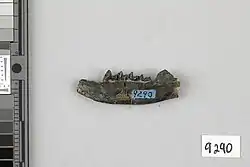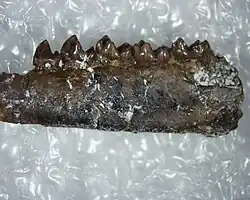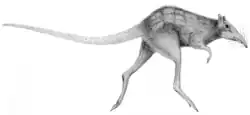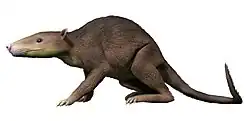Pentacodontidae
| Pentacodontidae Temporal range: early to late Paleocene
| |
|---|---|

| |
| mandibula of Aphronorus fraudator | |

| |
| mandibula of Bisonalveus browni | |
| Scientific classification | |
| Kingdom: | Animalia |
| Phylum: | Chordata |
| Class: | Mammalia |
| Mirorder: | Ferae |
| Order: | †Pantolesta |
| Family: | † Simpson, 1937[1] |
| Type genus | |
| †Pentacodon Scott, 1892
| |
| Genera | |
| |
| Synonyms | |
| |
Pentacodontidae ("teeth with five points") is an extinct family of placental mammals from extinct order Pantolesta, that lived in North America and Europe[2] from the early to late Paleocene.[3][4]
Classification and phylogeny
Taxonomy
|
References
- ^ G. G. Simpson (1937.) "The Fort Union of the Crazy Mountain field, Montana and its mammalian faunas." Bulletin of the United States National Museum 169:1-287
- ^ Eric De Bast; Thierry Smith (2016). "The oldest Cenozoic mammal fauna of Europe: implication of the Hainin reference fauna for mammalian evolution and dispersals during the Paleocene". Journal of Systematic Palaeontology. 15 (9): 741–785. doi:10.1080/14772019.2016.1237582. S2CID 89203431.
- ^ L. Van Valen (1967.) "New Paleocene insectivores and insectivore classification." Bulletin of the American Museum of Natural History 135(5):217-284
- ^ Malcolm C. McKenna, Susan K. Bell: Classification of Mammals: Above the Species Level in Columbia University Press, New York (1997), 631 Seiten.


